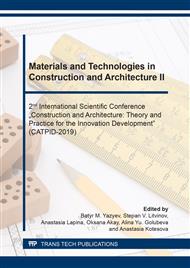[1]
Krivoborodov Yu.V., Elenina A.A. Hardening of cement stone with microdisperse additives, Technique and technology of silicates. 22 (4) (2015) 18-20.
Google Scholar
[2]
T.S. Shepelenko, N.P. Gorlenko, O.A. Zubkova, Cement composites modified with electrolytic additives. Magazine of Civil Engineering. 81 (5) (2018) 125–134. doi: 10.18720 / MCE.81.13.
DOI: 10.5862/mce.66.1
Google Scholar
[3]
Timoshenko T.I., Zalogina A.V., Khudasov V.I. Zinc and BaSO4 additives for construction. 1 (3) (2018) 17–24.
Google Scholar
[4]
Kuznetsova TV, Nefedyev A.P., Kossov D.Yu. Kinetics of hydration and properties of cement with the addition of metakaolin, building materials. 7 (2015) 3-4.
Google Scholar
[5]
E.A. Shoshin, A.V. Polyacetic acid, modified sucrose, Bulletin of BSTU named after V.G. Shukhov. 1 (2018) 76–81.
Google Scholar
[6]
Richardson I.G. The calcium silicate hydrates, Cement and Concrete Research. 38 (2008) 137-158.
DOI: 10.1016/j.cemconres.2007.11.005
Google Scholar
[7]
Klassen V.K., Morozova I.A., Borisov I.N., Mandrikova O.S. Energy saving material raw material component, Middle East Journal of Scientific Research. 18 (11) (2013) 1597-1601.
Google Scholar
[8]
Egorov G.V., Kapralova R.M., Chibisov N.P., Ermakov G.F. Comparison of strength properties with isobaric-isothermal hydration potentials of Portland cement clinkers, Cement. 8 (1987) 10-11.
Google Scholar
[9]
Butt Yu.M., Timashev V.V. Influence of the phase composition of Portland cement clinkers on the cement binding properties, Proceedings of the Scientific Research Institute Cement. Moscow, Gosstroyizdat. 17 (1962) 85-121.
Google Scholar
[10]
Rakhimbaev Sh.M. Transfer kinetics in heterogeneous processes of building materials technology, Sat. scientific proceedings Physical chemistry of building and composite materials. Publishing house BTISM, Belgorod, 989.
Google Scholar
[11]
Rakhimbaev Sh.M. Calculation of rate constants of some processes of technology of artificial conglomerates, Coll. scientific works Problems of materials science and improvement of production technology of building products, Publishing house BTISM, Belgorod, (1990).
Google Scholar


